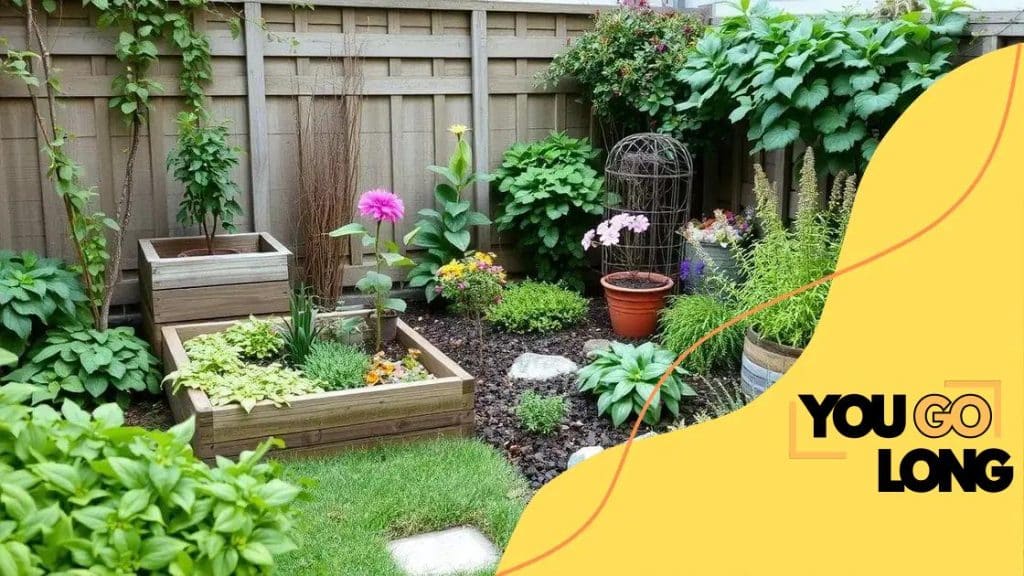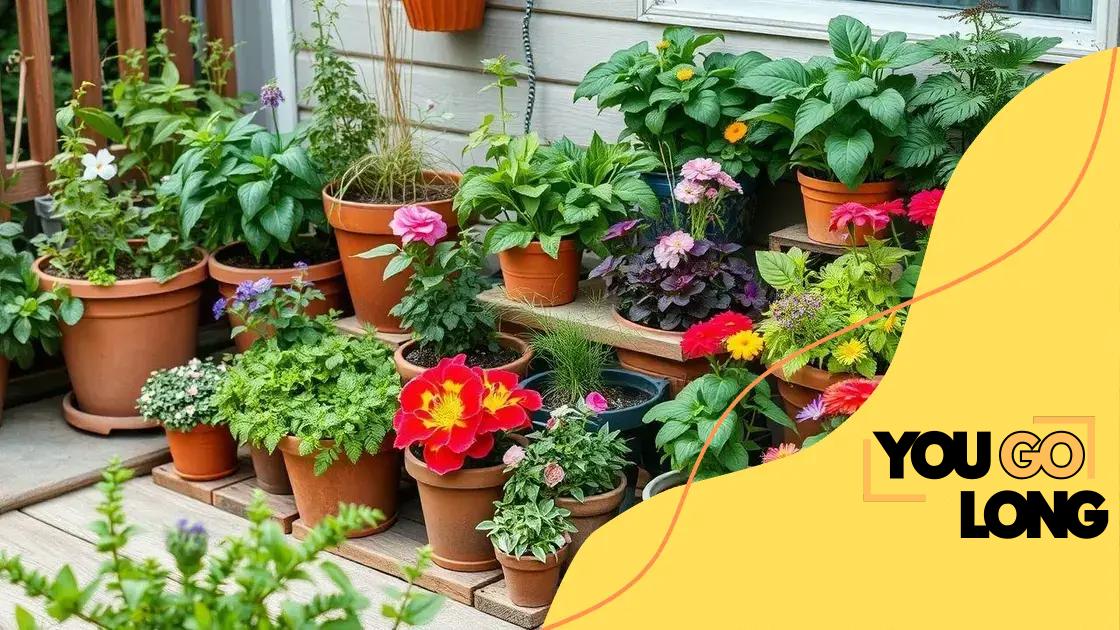How to make the most of garden space in a small yard

Advertisement
To make the most of garden space in a small yard, use vertical gardening, select compact plants, maximize sunlight access, and implement efficient watering techniques.
How to make the most of garden space in a small yard can feel overwhelming at first. But with a little creativity and planning, you can transform your limited space into a flourishing garden oasis. Ready to dive in?
Assessing your available garden space
When you’re learning how to make the most of garden space in a small yard, the first step is assessing your available garden space. Knowing what you have to work with sets the foundation for your gardening plans. Start by looking at the size of your yard, the shape of the space, and any existing features that could affect your garden layout.
Consider taking measurements. This helps you understand the dimensions of your garden effectively. You can sketch a rough layout to visualize where plants could go. Don’t forget to note where sunlight hits the yard during the day. This information will guide you in selecting the right plants.
Advertisement
Identifying Gardens in Your Home
Next, inspect the ground and surrounding areas closely. Look for:
- Spaces that receive direct sunlight.
- Shady areas under trees or buildings.
- Parts of your yard that collect water.
- Windy spots that could affect plant growth.
By categorizing your yard this way, you’ll find the best spots for different types of plants. For instance, sun-loving flowers should go in areas that face the sun directly, while greens might be better suited for cooler, shaded spots. This creates a balanced garden that thrives on the specific conditions of your space. Evaluate the soil quality next—good soil is vital for a successful garden. If it’s too rocky or heavily compacted, you might need to amend it before planting.
Considering What You Want to Grow
Think also about what you want to grow. Are you looking for vegetables, herbs, or flowers? Each type needs different conditions. For example, if you plan on having vegetables, ensure you have enough room for their root systems. Drawing a rough plan can indicate how much space each plant might need once it grows.
Advertisement
As you continue your assessment, remember that creativity plays a big role in small spaces. You can utilize containers or vertical gardening to add more plants without taking up additional ground area. Every square inch counts!
Vertical gardening techniques
One effective way to maximize your small yard is through vertical gardening techniques. This method allows you to make the most of your limited space by utilizing vertical surfaces like walls, fences, or trellises. Vertical gardening not only saves ground space but also adds aesthetic appeal to your garden.
Before you start, consider the types of structures you can use. You might want to try:
- Wall planters that attach directly to fences or walls.
- Trellises for climbing plants like beans and cucumbers.
- Hanging baskets to display flowers or herbs.
- Pallet gardens that reuse wooden pallets for planting.
These structures create more room for plants and make them easier to access. When planning your vertical garden, think about the sunlight each area receives and choose plants that will thrive in those conditions. Remember to consider watering needs and make your watering system accessible.
Choosing the Right Plants
Some plants are better suited for vertical gardening than others. Popular choices include vining plants, herbs, and flowers. Vining plants, such as tomatoes and peas, can climb trellises easily, making them perfect for vertical gardening. Herbs like basil and parsley can also be grown in wall planters or hanging pots, providing fresh ingredients right outside your door.
Before planting, make sure to arrange your plants based on their growth habits. Compact plants should go on lower levels, while taller varieties can occupy the upper areas. This not only promotes healthy growth but also ensures that all plants receive adequate sunlight.
Using vertical space creatively can transform your tiny yard into a lush garden. Incorporating these vertical gardening techniques will allow you to grow more and enjoy a beautiful green space, even in limited areas.
Container gardening for small spaces

Container gardening is a fantastic solution when you want to make the most of your limited outdoor space. This approach allows you to grow a variety of plants in pots, making it perfect for small yards or even balconies. With container gardening, you can create a beautiful garden without needing a large plot of land.
One of the first steps is to choose the right containers. You can use:
- Plastic pots that are lightweight and come in many sizes.
- Clay pots that provide good drainage but can be heavy.
- Wooden boxes that add a rustic feel and can be customized.
- Vertical planters that maximize space by stacking.
Make sure your containers have drainage holes to prevent overwatering, which can harm your plants. You can fill your containers with high-quality potting soil, which retains moisture while providing the nutrients your plants need.
Selecting the Right Plants
When it comes to container gardening for small spaces, choosing the right plants is essential. Opt for compact varieties that suit your containers well. Great choices include:
- Herbs like basil, cilantro, and thyme.
- Small vegetables such as cherry tomatoes and peppers.
- Flowers like petunias or marigolds that add color.
Mixing different plants in one container can also create a visually appealing arrangement. Just ensure that their light and water needs are similar. Grouping plants with the same requirements keeps your gardening efforts simpler and more effective.
Position your containers where they will receive the best sunlight. Most plants thrive with at least six hours of direct sunlight, so be mindful of this when placing them. You can also move your containers around easily as the seasons change to ensure your plants get the light they need.
Container gardening offers a versatile way to enjoy gardening without the constraints of traditional planting. By embracing this method, you can create a lively garden even in the smallest spaces.
Choosing the right plants for smaller yards
Choosing the right plants for smaller yards is a crucial step in maximizing your garden’s potential. With limited space, it’s essential to select plants that not only fit your aesthetic but also thrive in the conditions available. Start by considering the climate in your area and choose plants that are well-suited for your local environment.
Many small yards benefit from utilizing native plants. Native plants are adapted to local conditions and generally require less maintenance. Additionally, they attract local wildlife, such as pollinators, which can enhance your garden’s ecosystem. Take a moment to explore:
- Flowering plants like daylilies and coneflowers.
- Compact shrubs such as boxwoods or dwarf ornamental grasses.
- Vegetables that grow in smaller spaces, like lettuce and radishes.
When selecting your plants, consider their growth habits. Opt for varieties that remain compact rather than sprawling. Utilize vertical gardening techniques, which allow you to grow plants upwards instead of outwards, saving valuable ground space while creating an attractive display.
Grouping Plants for Visual Appeal
Another approach is to group your plants based on their height and color. For instance, place taller plants at the back of a flower bed and shorter ones at the front. Mixing colors can create a vibrant look without overwhelming the available space. Also, consider using plants that can serve multiple purposes, like edible flowers or aromatic herbs.
Don’t forget about seasonal interest! Select a mix of perennials that bloom at different times of the year to ensure continuous color and textural interest. Incorporating evergreens can provide structure even during winter months when other plants may be dormant.
Choosing the right plants can make your small garden feel lush and inviting. By focusing on size, maintenance, and seasonal interest, you can create a stunning garden that makes the most of your limited space.
Maximizing sunlight and water access
To create a flourishing garden in a small yard, it’s essential to focus on maximizing sunlight and water access. These two elements are vital for plant health and growth. Properly assessing your yard’s layout helps you identify the best spots for planting. Understanding the sun’s path during different times of the year will guide you in choosing the ideal locations for your plants.
When it comes to sunlight, aim for areas that receive at least six hours of direct sunlight each day. Observe your yard during peak sunlight hours to spot any shaded areas caused by trees, fences, or buildings. You can:
- Trim overgrown trees and shrubs to enhance light exposure.
- Use reflective surfaces, like white walls or patio stones, to bounce light onto shadier spots.
- Choose plants that thrive in partial shade for those tricky corners.
Water access is equally important for a healthy garden. Installing a simple irrigation system or using soaker hoses can ensure your plants receive consistent moisture without wastage. When watering, aim for the base of the plants to minimize evaporation and promote deeper root growth.
Group Plants by Water Needs
Grouping plants with similar watering needs can simplify your garden maintenance. For example, placing drought-tolerant plants together enables you to tailor your watering schedule effectively. On the other hand, moisture-loving plants can reside in areas that retain water better, preventing them from drying out.
Also, consider using mulch around your plants. Mulch helps retain soil moisture, regulates temperature, and prevents weed growth. This technique not only saves water but also keeps your plants healthy by providing a stable environment.
Maximizing sunlight and water access in your small yard can significantly enhance your gardening success. By using strategic placements and thoughtful maintenance, you can realize the full potential of your garden.
In summary, making the most of garden space in a small yard requires careful planning and creativity. By using techniques such as vertical gardening, container gardening, and choosing the right plants, you can create a thriving green space. Maximizing sunlight and water access also plays a crucial role in ensuring your plants grow healthy and strong. With these strategies, even the smallest yard can become a beautiful and productive garden that brings joy and beauty to your home.
FAQ – Frequently Asked Questions About Maximizing Garden Space
What are the benefits of vertical gardening in small spaces?
Vertical gardening allows you to grow more plants in less ground space, improving aesthetics and making it easier to care for your garden.
How can I choose the right plants for a small yard?
Select compact or native plants that thrive in your climate, ensuring they fit well within limited space and require minimal maintenance.
What strategies can I use to maximize sunlight access for my plants?
Observe your yard to identify sunny spots, prune overhanging branches, and use reflective surfaces to enhance light exposure.
How do I effectively water my plants in a small garden?
Implementing a drip irrigation system or using soaker hoses can ensure consistent moisture, focusing on watering at the base of the plants.





